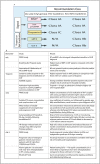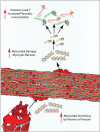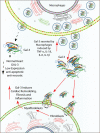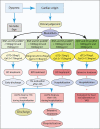Biomarkers in the management of acute heart failure: state of the art and role in COVID-19 era
- PMID: 34609075
- PMCID: PMC8652929
- DOI: 10.1002/ehf2.13595
Biomarkers in the management of acute heart failure: state of the art and role in COVID-19 era
Abstract
Acute heart failure (AHF) affects millions of people worldwide, and it is a potentially life-threatening condition for which the cardiologist is more often brought into play. It is crucial to rapidly identify, among patients presenting with dyspnoea, those with AHF and to accurately stratify their risk, in order to define the appropriate setting of care, especially nowadays due to the coronavirus disease 2019 (COVID-19) outbreak. Furthermore, with physical examination being limited by personal protective equipment, the use of new alternative diagnostic and prognostic tools could be of extreme importance. In this regard, usage of biomarkers, especially when combined (a multimarker approach) is beneficial for establishment of an accurate diagnosis, risk stratification and post-discharge monitoring. This review highlights the use of both traditional biomarkers such as natriuretic peptides (NP) and troponin, and emerging biomarkers such as soluble suppression of tumourigenicity (sST2) and galectin-3 (Gal-3), from patients' emergency admission to discharge and follow-up, to improve risk stratification and outcomes in terms of mortality and rehospitalization.
Keywords: Acute heart failure; Biomarkers; Diagnosis; Follow-up; Mortality; Risk stratification.
© 2021 The Authors. ESC Heart Failure published by John Wiley & Sons Ltd on behalf of European Society of Cardiology.
Conflict of interest statement
None declared.
Figures







Similar articles
-
Biomarkers in diagnosing and treatment of acute heart failure.Biomark Med. 2019 Oct;13(14):1235-1249. doi: 10.2217/bmm-2019-0134. Epub 2019 Oct 3. Biomark Med. 2019. PMID: 31580155 Review.
-
A multimarker multi-time point-based risk stratification strategy in acute heart failure: results from the RELAX-AHF trial.Eur J Heart Fail. 2017 Aug;19(8):1001-1010. doi: 10.1002/ejhf.749. Epub 2017 Jan 30. Eur J Heart Fail. 2017. PMID: 28133908 Clinical Trial.
-
Triple head-to-head comparison of fibrotic biomarkers galectin-3, osteopontin and gremlin-1 for long-term prognosis in suspected and proven acute heart failure patients.Int J Cardiol. 2016 Jan 15;203:398-406. doi: 10.1016/j.ijcard.2015.10.127. Epub 2015 Oct 20. Int J Cardiol. 2016. PMID: 26539964 Clinical Trial.
-
Prognostic Role of sST2 in Acute Heart Failure and COVID-19 Infection-A Narrative Review on Pathophysiology and Clinical Prospective.Int J Mol Sci. 2022 Jul 26;23(15):8230. doi: 10.3390/ijms23158230. Int J Mol Sci. 2022. PMID: 35897800 Free PMC article. Review.
-
Diagnostic and prognostic accuracy of galectin-3 and soluble ST2 for acute heart failure.Clin Chim Acta. 2016 Dec 1;463:158-164. doi: 10.1016/j.cca.2016.10.034. Epub 2016 Oct 29. Clin Chim Acta. 2016. PMID: 27983996
Cited by
-
Utility of cardiac bioenzymes in predicting cardiovascular outcomes in SARS-CoV-2.World J Virol. 2022 Sep 25;11(5):375-390. doi: 10.5501/wjv.v11.i5.375. World J Virol. 2022. PMID: 36188743 Free PMC article.
-
Emergency department risk assessment and disposition of acute heart failure patients: existing evidence and ongoing challenges.Heart Fail Rev. 2023 Jul;28(4):781-793. doi: 10.1007/s10741-022-10272-4. Epub 2022 Sep 20. Heart Fail Rev. 2023. PMID: 36123519 Free PMC article. Review.
-
Soluble ST2 as a Useful Biomarker for Predicting Clinical Outcomes in Hospitalized COVID-19 Patients.Diagnostics (Basel). 2023 Jan 10;13(2):259. doi: 10.3390/diagnostics13020259. Diagnostics (Basel). 2023. PMID: 36673069 Free PMC article.
-
Biomarkers of Importance in Monitoring Heart Condition After Acute Myocardial Infarction.J Clin Med. 2024 Dec 29;14(1):129. doi: 10.3390/jcm14010129. J Clin Med. 2024. PMID: 39797212 Free PMC article. Review.
-
Galectin-3 as a Marker for Increased Thrombogenicity in COVID-19.Int J Mol Sci. 2023 Apr 22;24(9):7683. doi: 10.3390/ijms24097683. Int J Mol Sci. 2023. PMID: 37175392 Free PMC article.
References
-
- Lippi G, Sanchis‐Gomar F. Global epidemiology and future trends of heart failure. AME Med J. 2020; 5: 15.
-
- Farmakis D, Papingiotis G, Parissis J. Acute heart failure: epidemiology and socioeconomic burden. Contin Cardiol Educ. 2017; 3: 88–92.
-
- Ponikowski P, Voors AA, Anker SD, Bueno H, Cleland JG, Coats AJ, Falk V, González‐Juanatey JR, Harjola VP, Jankowska EA, Jessup M, Linde C, Nihoyannopoulos P, Parissis JT, Pieske B, Riley JP, Rosano GMC, Ruilope LM, Ruschitzka F, Rutten FH, van der Meer P. 2016 ESC Guidelines for the diagnosis and treatment of acute and chronic heart failure: the Task Force for the diagnosis and treatment of acute and chronic heart failure of the European Society of Cardiology (ESC) Developed with the special contribution of the Heart Failure Association (HFA) of the ESC. Eur J Heart Fail. 2016; 18: 891–975. - PubMed
Publication types
MeSH terms
Substances
LinkOut - more resources
Full Text Sources
Medical
Miscellaneous

